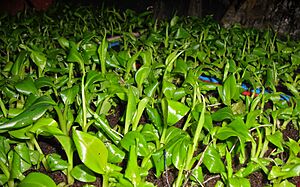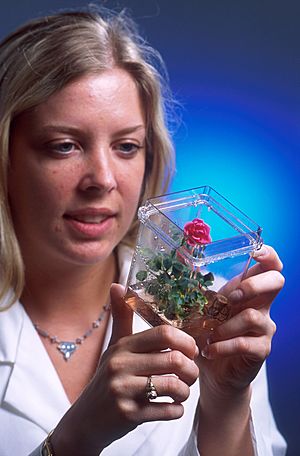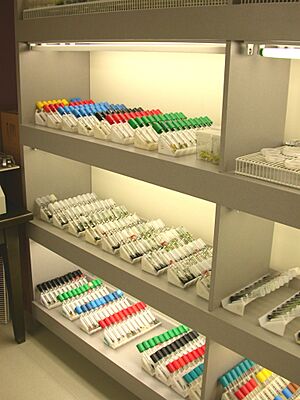Micropropagation facts for kids
Micropropagation is a cool way to grow lots of new plants very quickly. It's also called tissue culture. Imagine taking a tiny piece of a plant, like a few cells, and using it to make thousands of exact copies!
This method is super useful for many types of plants. For example, it helps grow plants that don't make seeds, or plants that are hard to grow from cuttings. It's also great for making many copies of special plants, like those that have been improved by scientists. A scientist named Frederick Campion Steward first started using these methods in the 1950s and 1960s.
Contents
How Plants Are Grown Using Micropropagation
Growing plants with micropropagation happens in a few main steps. It's like a special journey for the plant cells!


Here are the four main stages:
- Choosing the Parent Plant: First, scientists pick a healthy "mother plant" that they want to copy. They take a very small piece from it.
- Making More Copies: This tiny piece is put into a special liquid or jelly that has all the food and hormones the plant needs to grow. In this clean environment, the plant cells start to multiply and form many tiny new shoots.
- Growing Roots and Getting Ready: Once there are enough tiny shoots, they are moved to a different special mix. This mix helps them grow strong roots. After that, they slowly get used to normal air and light, like preparing for the outside world.
- Moving to Soil: Finally, the tiny new plants, now with roots, are carefully moved into soil. They can then grow into full-sized plants, just like the original parent plant!
Benefits of Micropropagation
Micropropagation has many cool advantages over older ways of growing plants:
- Lots of Copies: You can make thousands of exact copies, or "clones," of one plant very quickly.
- Healthy Plants: This method helps create plants that are free from diseases. This is because the process is done in a very clean, sterile environment.
- Special Plants: It's the best way to grow plants that have been changed by scientists. It also helps grow plants that don't make many seeds, or plants that are sterile (can't make seeds at all).
- Stronger Growth: Plants grown this way often grow faster and stronger than those grown from seeds or cuttings.
- Space Saving: You can grow a huge number of plants in a small area. This is great for nurseries and farms.
- Rare Plants: It's very helpful for growing rare plants, like many types of orchids, which have tiny seeds that are hard to grow normally.
Challenges of Micropropagation
Even though micropropagation is amazing, it also has some challenges:
- High Cost: It can be expensive because it needs a lot of careful work by people in a lab.
- All the Same: Since all the plants are exact copies, if one plant gets a disease, all the others might get it too. They don't have different strengths to fight off sickness.
- Not for Every Plant: Not all plants can be grown using this method. Sometimes, scientists haven't found the right food mix for them.
- Hard to Clean: Some plants are very hard to clean completely from tiny fungi or other germs.
For many common plants, growing from seeds is still cheaper and easier. But for special plants, or when you need many exact copies, micropropagation is a powerful tool!
Uses of Micropropagation
Micropropagation is used in many important ways:
- Saving Space: It helps grow and store many plants in small areas. This saves money and space.
- Protecting Plants: It's used to store plant material (called germplasm) and help protect plants that are in danger of disappearing.
- Beautiful Flowers: It's widely used for growing ornamental plants, like chrysanthemums, damask roses, and African violets. This helps flower growers produce many uniform, healthy plants for sale.
- Fruit Trees: It can also be used for fruit trees, like pears.
Images for kids









